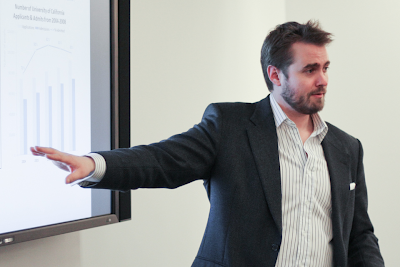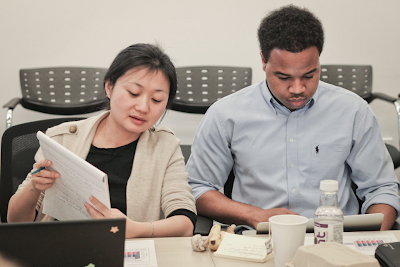Become a public speaking pro: learning how to present the next great idea
April 4th, 2013 | Published in Google Blog
This is the third post in a series profiling Googlers who facilitate classes as part of our g2g program, in which Googlers teach, share and learn from each other. Regardless of role, level or location, g2g's community-based approach makes it possible for all Googlers to take advantage of a variety of learning opportunities. - Ed.
If only public speaking were actually that easy. We’re often asked to present in front of a group, so good presentation skills are really important. Fear of public speaking is often ranked higher than fear of spiders, flying and heights. While spiders can make me jumpy, I not only enjoy public speaking, I also teach it.
In addition to my core role as Google Toronto’s agency team lead (helping to nurture relationships with some of the largest ad agencies in Canada), I help my colleagues amp up their public speaking skills as a g2g (Googler-to-Googler) facilitator for two classes, “Presenting with Confidence” and “Presenting with Charisma.” These two classes help my fellow Googlers erase anxiety and self-doubt and focus on the goal—communicating your message. I am actually a mechanical engineer by trade who, at one point, entered graduate school to study robotics. Not exactly the type that comes to mind when you think of great orators. But I’ve learned along the way, as an engineer turned “sales guy,” that a confident demeanor and a little charm can turn a snooze-fest into an engaging, lively meeting.

“Presenting with Confidence” goes beyond the “picture the audience in their underwear” adage. First, students are tasked with making brief presentations about themselves, whether it be about their most recent vacation or how they play in a jazz band. We videotape the students giving their presentations on their phones to review later as a part of the exercise and to keep for their own reference. This, as it turns out, is one of the most effective, eye-opening exercises in the class. Before we roll the tape, the participant comments on an area he/she believes will be pointed out by others, such as, “I always fidget with my hands” or, “I blush as red as a tomato.” The reality is often completely different, and provides an immediate boost of confidence, allowing the student to focus on the content of their presentation. Part of the confidence boost also stems from being surrounded by peers who are in the same boat, so there’s no judgment.

“Presenting with Charisma” focuses on adding charm and magnetism to your speech. The more the audience wants to hear from a speaker, the more information they’ll absorb. In this class, Googlers nail down the right mix of tone, body language and delivery to better captivate their audience. We role play to learn how to conquer inevitable yet potentially disastrous moments, like when your technology demo crashes.
I experienced one such moment myself when I covered a presentation for a fellow Googler at the last minute. When I started getting asked questions that were beyond my ability to handle, I followed the advice I give my own students, which is to remain calm, upbeat and easy-going—no matter what. I decided to play off the audience’s own knowledge so that the Q&A became more of a dialogue rather than the spotlight shining solely on me.
Solid communication skills anchor any job function. Whether you are an engineer presenting new findings to your manager or a salesperson pitching a new business strategy to a client, a few tips and a lot of practice can make a significant impact on your presentations. If you’re one of the many, many professionals who feels uneasy about getting up in front of a room full of people, try the following tried-and-true techniques to start mastering the art of public speaking.
Tips and tricks to boost your public speaking confidence and charisma:
1) Pace yourself. To slow down and build momentum, try reciting a sentence then walking to the other side of the room. Pause, then walk back to the other side and deliver your next sentence.
2) Unfreeze. What to do if you totally freeze during your presentation? Look at your slide or notes and just describe what you see on the slide or page in front of you. The words will start flowing and come back to you.
3) Fidget and fiddle no more. Displacement tactic: if you find yourself always fiddling with your hands or keeping your hands in your pockets, try standing behind a chair or a podium and planting your hands on the podium so you appear confident. (Even political leaders use this trick.)
4) Get physical. Use the room to your advantage and keep your audience alert. Walk across the room or even among the audience to get people involved in your presentation.
5) Stop saying “Um.” To rid yourself of “umm”-ing your way through a presentation, use this physical displacement tactic: Every time you are transitioning from one point to another, do something small but physical, like moving your pen. Making a conscious effort to move the pen will turn your brain off from using a verbal filler instead.
“[Public speaking] is quite simple, say what you have to say and
when you come to a sentence with a grammatical ending, sit down.” —Winston Churchill
If only public speaking were actually that easy. We’re often asked to present in front of a group, so good presentation skills are really important. Fear of public speaking is often ranked higher than fear of spiders, flying and heights. While spiders can make me jumpy, I not only enjoy public speaking, I also teach it.
In addition to my core role as Google Toronto’s agency team lead (helping to nurture relationships with some of the largest ad agencies in Canada), I help my colleagues amp up their public speaking skills as a g2g (Googler-to-Googler) facilitator for two classes, “Presenting with Confidence” and “Presenting with Charisma.” These two classes help my fellow Googlers erase anxiety and self-doubt and focus on the goal—communicating your message. I am actually a mechanical engineer by trade who, at one point, entered graduate school to study robotics. Not exactly the type that comes to mind when you think of great orators. But I’ve learned along the way, as an engineer turned “sales guy,” that a confident demeanor and a little charm can turn a snooze-fest into an engaging, lively meeting.

Here I am teaching one of our Presenting with Confidence classes in our New York City office.
Photo by Jane Hu.
“Presenting with Confidence” goes beyond the “picture the audience in their underwear” adage. First, students are tasked with making brief presentations about themselves, whether it be about their most recent vacation or how they play in a jazz band. We videotape the students giving their presentations on their phones to review later as a part of the exercise and to keep for their own reference. This, as it turns out, is one of the most effective, eye-opening exercises in the class. Before we roll the tape, the participant comments on an area he/she believes will be pointed out by others, such as, “I always fidget with my hands” or, “I blush as red as a tomato.” The reality is often completely different, and provides an immediate boost of confidence, allowing the student to focus on the content of their presentation. Part of the confidence boost also stems from being surrounded by peers who are in the same boat, so there’s no judgment.

Sharing honest feedback with your peers is an important part of the learning process.
Photo by Jane Hu.
“Presenting with Charisma” focuses on adding charm and magnetism to your speech. The more the audience wants to hear from a speaker, the more information they’ll absorb. In this class, Googlers nail down the right mix of tone, body language and delivery to better captivate their audience. We role play to learn how to conquer inevitable yet potentially disastrous moments, like when your technology demo crashes.
I experienced one such moment myself when I covered a presentation for a fellow Googler at the last minute. When I started getting asked questions that were beyond my ability to handle, I followed the advice I give my own students, which is to remain calm, upbeat and easy-going—no matter what. I decided to play off the audience’s own knowledge so that the Q&A became more of a dialogue rather than the spotlight shining solely on me.
Solid communication skills anchor any job function. Whether you are an engineer presenting new findings to your manager or a salesperson pitching a new business strategy to a client, a few tips and a lot of practice can make a significant impact on your presentations. If you’re one of the many, many professionals who feels uneasy about getting up in front of a room full of people, try the following tried-and-true techniques to start mastering the art of public speaking.
Tips and tricks to boost your public speaking confidence and charisma:
1) Pace yourself. To slow down and build momentum, try reciting a sentence then walking to the other side of the room. Pause, then walk back to the other side and deliver your next sentence.
2) Unfreeze. What to do if you totally freeze during your presentation? Look at your slide or notes and just describe what you see on the slide or page in front of you. The words will start flowing and come back to you.
3) Fidget and fiddle no more. Displacement tactic: if you find yourself always fiddling with your hands or keeping your hands in your pockets, try standing behind a chair or a podium and planting your hands on the podium so you appear confident. (Even political leaders use this trick.)
4) Get physical. Use the room to your advantage and keep your audience alert. Walk across the room or even among the audience to get people involved in your presentation.
5) Stop saying “Um.” To rid yourself of “umm”-ing your way through a presentation, use this physical displacement tactic: Every time you are transitioning from one point to another, do something small but physical, like moving your pen. Making a conscious effort to move the pen will turn your brain off from using a verbal filler instead.